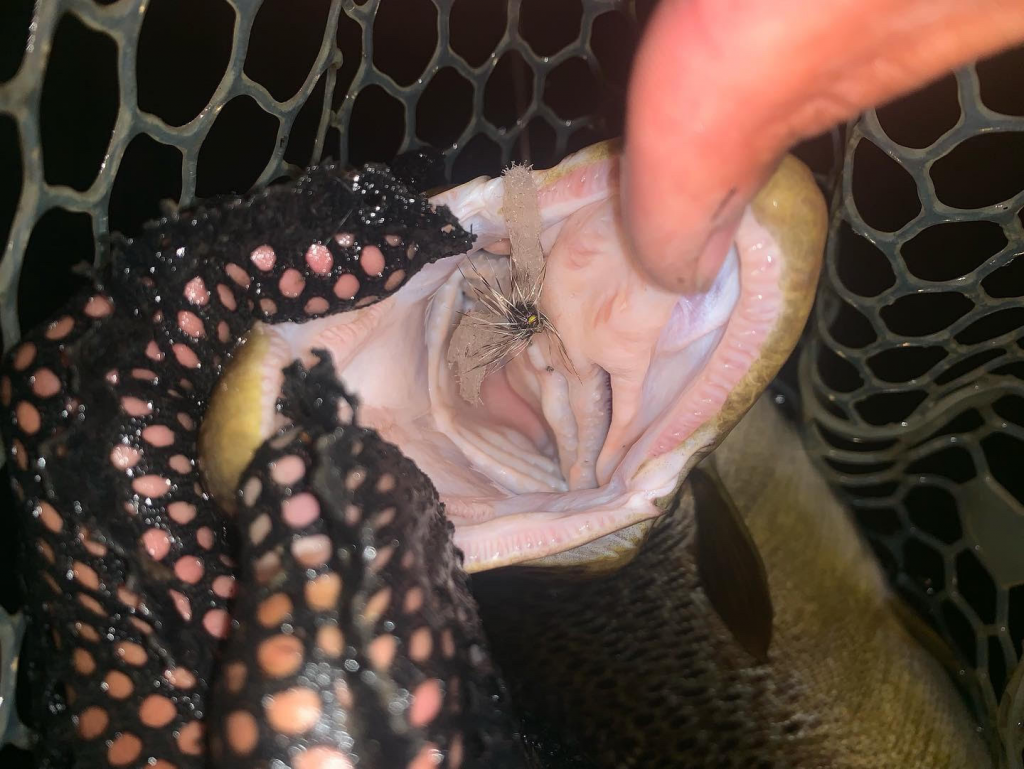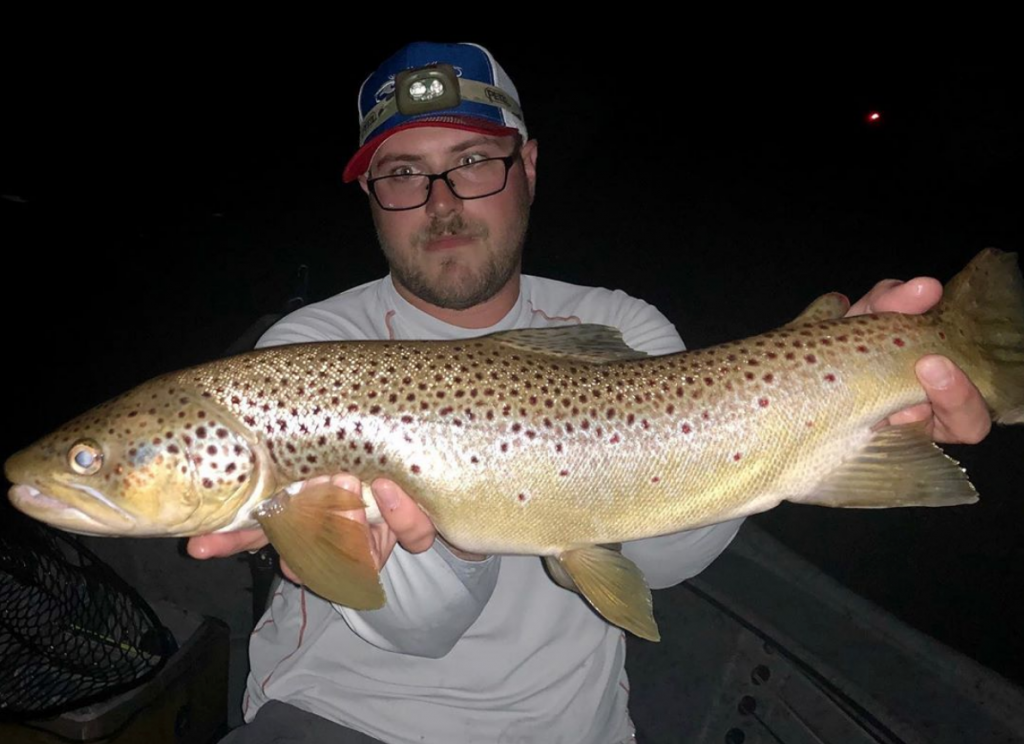
Hex is here! Hex is here! Read all about it!
This two-part report focuses on what hex fishing is all about, but more importantly the etiquette of night fishing. Making the hex hatch can be a bucket list item for many people across the world. Hex is short for Hexagenia limbata and Hexagenia Ricovada, which are the largest mayflies in North America. The hex hatch can be one of the best chances to catch a trophy brown trout.
Planning ahead for the hatch can be difficult because it is so dependent upon certain weather conditions. Generally we see the hex hatch peak sometime in mid June, but this year it is about two weeks behind due to the constant rain and cold nights. For a hatch to happen we generally look for at least three consecutive days of warm weather, ideally over 80 degrees and around 65 to 70 degrees at night. In addition to the warm weather, we also like to see the temperature of the water at or above 60 degrees. High and stained water can be less than ideal for fishing the hatch as it can make it more difficult for the fish to see what is happening on the surface. Luckily the Hexagenia Limbata is a massive mayfly that can be two-plus inches at the body with a long forked tail which still can be seen even in the milky stained conditions like we currently have on the Pere Marquette river.

What to look for in your fly selection:
There are a multitude of patterns to choose from for hex fishing. Picking your fly can be based on a few different things. Hex nymphs can be fished throughout the year as they spend the majority of their lifetime in the nymph stage. During the hatch itself you can fish emerger patterns early in the hatch, then the dun patterns, and lastly the spinners. The term emerger refers to the time in which the hex is working its way out of its nymph shell; its body will be half in the water and half on the surface. The term dun refers to the hex when it’s on the water, but still has its wings upright. Last but not least, the spinner. Hex hatch in mud-like sediment and will fly upriver from the swampier bog-type areas to mate. After they mate they will land on the water to lay their eggs. There may be a one to three-day period in between the time in which they mate, lay eggs, and eventually have a spinner fall. Hex will fly upriver in abundant numbers, then as they mate and die their wings will fall horizontal and they will float down the river. Spinners represent the dead hex with its wings down horizontal laying flat to the water. Spinner patterns can also be modified into crippled hex’s, which may have clipped portions of the fly, missing wings, or bent bodies. If fish are refusing your fly you can always bend it or cut it to give it a different look.
It is not rare to see so many hex spinners floating down the river that it completely covers the surface of the river like a layer of carpet. Emerger patterns can be fished early in the night, duns can be fished for about an hour when the hex are still lively, and then the spinners can be fished for hours and hours through the night as dead hex will be everywhere.

Fly patterns can either be made from natural materials that require some floatant or can be constructed of foam-like materials, which easily float on their own. Different tiers use a variety of materials to create different looks for wings, such as rubber legs or clear plastic material to imitate the translucent wings of the hex. Have a variety of different patterns in your arsenal that can be used for different situations. Some patterns use a translucent material to create a glow post which makes it very easy to see your fly even in the pitch dark. Scientific Anglers even makes a magnum glow line that can be extremely helpful to be able to see your cast.
The touchy etiquette of night fishing:
Now to the important part: the etiquette of fishing at night. When fishing at night your senses are dialed in; watching for bug activity and listening closely for rising fish. Being loud or shining a white light can be a huge disruption to other fishermen and can easily cause tension on the river. Keep in mind, that a lot of fishermen wait all year and come from far away to fish the hatch. With hex fishing being some of the best fishing of the year, it only lasts for a short duration of time, and having sensitive conditions often leads to more tension on the river than any other time of year. Everyone is out there with the same main goal and there is plenty of water for anyone.
Here are some key tips:
1) Communication between fishermen is key! If you are floating down the river and know there are fishermen below you, it is always best to ask what side of the river you should float on to avoid wrecking their spot. Rowing stealthily will not only up your chances of seeing rising fish, but will also keep other fishermen happy. If you are in the water and see people upstream, you can let out a light whistle or turn your red light on when they are still far away. These can be courteous ways to let others know where you are and not disrupt their fishing.
2) Do not shine the water or other people with your light! Words cannot explain how frustrating it can be for someone to sit on a rising fish for a while and have another fisherman flash their light and not only scare the fish, but blind the fisherman. It takes a long time for your eyes to re-adjust after having a bright light flashed in your eyes.
3) If you need a light, always avoid using any white light and instead use a red or green light. Many headlamps have a red light which can be used to help navigate tricky water, trails, and tying knots. If possible, avoid using any light.
4) When at all possible do your best to spread out on the river even more than you normally would. With limited visibility you are more dependent upon hearing to locate fish. With this being said, having other fishermen around can be quite annoying when you are trying to listen for fish and you can hear someone else talking.
5) Again, communication is key! If you see someone out there who might not not fully understand the etiquette of night fishing, try and make them aware of what they are doing. They won’t ever learn unless we teach them. With that being said, help them learn in an encouraging way. If you are rude about it then most people will often not respect what you are saying and will continue to make the same mistakes. Lack of communication and animosity on the river will always result in a frustrating night of hex fishing.
With all of this being said, the world famous hex hatch is here. Get out there and have the time of your life! We just ask that you do it in a way so others have that opportunity as well. Again, if you take anything away from this article the two best things you can do is not flash lights on anyone and do your best to communicate with other fishermen. The hex will generally be happening for about one to three weeks. Hex doesn’t last long and trips are booking up quickly, so give us a call at the shop to reserve your trip of a lifetime!
As always, if you have any comments or questions in regards to this article please reach out to us at the fly shop by emailing us at staff@pmlodge.com or giving us a call at 231-745-3972.
